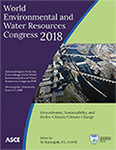World Environmental and Water Resources Congress 2018
Bayesian Augmented L-Moment Approach for Regional Frequency Analysis
Publication: World Environmental and Water Resources Congress 2018: Groundwater, Sustainability, and Hydro-Climate/Climate Change
ABSTRACT
The standard L-moment based regional frequency analysis (RFA) involves four steps: data screening, identification of homogenous region, selection of distribution, and estimation of associated parameters. This study augments the last two steps of RFA using Bayesian statistics in order to limit the subjectivity of distribution selection and account for parameter and model uncertainty. Bayesian model averaging (BMA) was employed along with multiple performance measures to combine distributions and provide a consensus prediction that avoids subjectivity and quantify modeling uncertainty. The differential evolution adaptive metropolis (DREAM) algorithm, the latest addition in MCMC sampling, was adopted to estimate parameters of selected distributions and quantify parameter uncertainty. The results based on extreme precipitation data from 85-station and 10-duration in Eastern U.S. suggest that the coupled BMA and DEARM delivers a less subjective prediction with a better performance than the single best distribution as measured by Taylor diagram, Anderson Darling, and Bootstrap efficiency measures.
Get full access to this chapter
View all available purchase options and get full access to this chapter.
REFERENCES
Ahmad, M. I., C. D. Sinclair, and B. D. Spurr.1988. “Assessment of Flood Frequency Models Using Empirical Distribution Function Statistics.” Water Resources Research 24(8):1323–28.
Bobée, B. G., Cavadias, F. Ashkar, J. Bernier, and P. Rasmussen. 1993. “Towards a Systematic Approach to Comparing Distributions Used in Flood Frequency Analysis.” Journal of Hydrology 142 (1–4):121–36.
Cohn, T. A., W. L. Lane, and W. G. Baier. 1997. “An Algorithm for Computing Moments-Based Flood Quantile Estimates When Historical Flood Information Is Available.” Water Resources Research 33(9):2089–96.
Dietterich, Thomas G. 2000. “Ensemble Methods in Machine Learning.” 1–15.
Fowler, H. J. and C. G. Kilsby. 2003. “A Regional Frequency Analysis of United Kingdom Extreme Rainfall from 1961 to 2000.” International Journal of Climatology 23(11): 13–34.
Gaál, Ladislav, Ján Szolgay, Silvia Kohnová, Kamila Hlavčová, and Alberto Viglione. 2010. “Inclusion of Historical Information in Flood Frequency Analysis Using a Bayesian MCMC Technique: A Case Study for the Power Dam Orlík, Czech Republic.” Contributions to Geophysics and Geodesy 40(2):121–47.
Gaume, E. et al.2010. “Bayesian MCMC Approach to Regional Flood Frequency Analyses Involving Extraordinary Flood Events at Ungauged Sites.” Journal of Hydrology 394 (1–2):101–17.
Gelman, Andrew and Donald Rubin, B. 1992. “Inference from Iterative Simulation Using Multiple Sequences.” Statistical Science 7(4):457–72.
Hall, M. J. H. F. P., van den Boogaard, R. C. Fernando, and A. E. Mynett. 2004. “The Construction of Confidence Intervals for Frequency Analysis Using Resampling Techniques.” Hydrology and Earth System Sciences 8(2):235–46.
Hoeting, Jennifer A., David Madigan, Adrian E. Raftery, and Chris T. Volinsky. 1999. “Bayesian Model Averaging: A Tutorial (with Comments by M. Clyde, David Draper and E. I. George, and a Rejoinder by the Authors.” Statistical Science 14(4):382–417.
Hosking, J. R. M. and J. R. Wallis. 1993. “Some Statistics Useful in Regional Frequency Analysis.” Water Resources Research 29(2):271–81.
Hosking, Jonathan R. M. 1990. “L-Moment – Analysis and Estimation of Distributions Using Linear-Combinations of Order-Statistics.” Journal of the Royal Statistical Society. Series B: Methodological 52(1).
Kidson, R. and K. S. Richards. 2005. “Flood Frequency Analysis: Assumptions and Alternatives.” Progress in Physical Geography 29(3):392–410.
Liang, Zhongmin, Wenjuan Chang, and Binquan Li. 2011. “Bayesian Flood Frequency Analysis in the Light of Model and Parameter Uncertainties.” Stochastic Environmental Research and Risk Assessment 26(5):721–30.
Moges, Edom, Yonas Demissie, and Hong-Yi Li. 2016. “Hierarchical Mixture of Experts and Diagnostic Modeling Approach to Reduce Hydrologic Model Structural Uncertainty.” Water Resources Researchn.
Murshed, Md, Sharwar, Sangil Kim, and Jeong-Soo Park. 2011. “Beta-κ Distribution and Its Application to Hydrologic Events.” 25(7):897–911.
Öztekin, Tekin. 2007. “Wakeby Distribution for Representing Annual Extreme and Partial Duration Rainfall Series.” Meteorological Applications 14(4):381–87.
Palmer, T. N. F. J., Doblas-Reyes, R. Hagedorn, and A. Weisheimer. 2005. “Probabilistic Prediction of Climate Using Multi-Model Ensembles: From Basics to Applications.” Philosophical transactions of the Royal Society of London. Series B, Biological sciences 360(1463):1991–98.
Polikar, R. 2006. “Ensemble Based Systems in Decision Making.” IEEE Circuits and Systems Magazine 6(3):21–45.
Raftery, Adrian E., Tilmann Gneiting, Fadoua Balabdaoui, and Michael Polakowski. 2005. “Using Bayesian Model Averaging to Calibrate Forecast Ensembles.” Monthly Weather Review 133(5):1155–74.
Reis, Dirceu S. and Jery R. Stedinger. 2005. “Bayesian MCMC Flood Frequency Analysis with Historical Information.” Journal of Hydrology 313 (1–2):97–116.
Sankarasubramanian, A. and K. Srinivasan. 1999. “Investigation and Comparison of Sampling Properties of L-Moments and Conventional Moments.” Journal of Hydrology 218 (1–2):13–34.
Singh, Vijay P. and W. G. Strupczewski. 2002. “On the Status of Flood Frequency Analysis.” Hydrological Processes 16(18):3737–40.
Stedinger, Jery R. and Timothy A. Cohn. 1986. “Flood Frequency Analysis With Historical and Paleoflood Information.” Water Resources Research 22(5):785–93.
Taylor, Karl E. 2001. “Summarizing Multiple Aspects of Model Performance in a Single Diagram.” Journal of Geophysical Research: Atmospheres 106(D7):7183–92.
Vrugt, J. A. and C. J. F. Ter_Braak. 2011. “DREAM(D): An Adaptive Markov Chain Monte Carlo Simulation Algorithm to Solve Discrete, Noncontinuous, and Combinatorial Posterior Parameter Estimation Problems.” Hydrology and Earth System Sciences 15(12):3701–13.
Wallis, J. R. M. G., Schaefer, B. L. Barker, and G. H. Taylor. 2007. “Regional Precipitation-Frequency Analysis and Spatial Mapping for 24-Hour and 2-Hour Durations for Washington State.” Hydrology and Earth System Sciences 11(1):415–42.
Wilks, Daniel S. 1993. “Comparison of Three-Parameter Probability Distributions for Representing Annual Extreme and Partial Duration Precipitation Series.” Water Resources Research 29(10):3543–49.
Information & Authors
Information
Published In
World Environmental and Water Resources Congress 2018: Groundwater, Sustainability, and Hydro-Climate/Climate Change
Pages: 165 - 180
Editor: Sri Kamojjala, Las Vegas Valley Water District
ISBN (Online): 978-0-7844-8141-7
Copyright
© 2018 American Society of Civil Engineers.
History
Published online: May 31, 2018
Authors
Metrics & Citations
Metrics
Citations
Download citation
If you have the appropriate software installed, you can download article citation data to the citation manager of your choice. Simply select your manager software from the list below and click Download.
